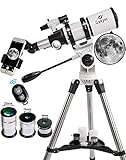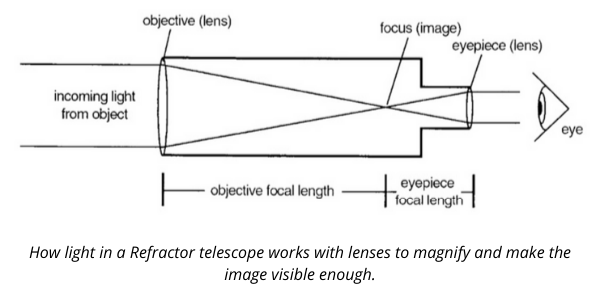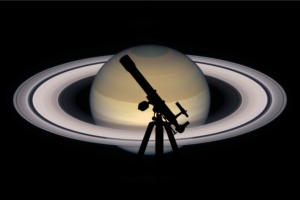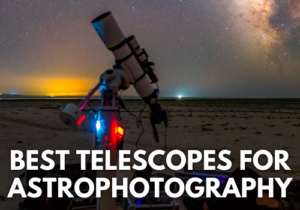9 Best Refractor Telescopes For Planets & Galaxies; Reviews
Disclosure: This post contains affiliate links and I may earn a small commission (at no extra cost to you) if you click through and make a purchase. Thanks in advance – I really appreciate it!
In this review of the best refractor telescopes, I have included a refractor telescope for everyone and for all-level users, from beginners to serious astrophotographers.
In researching these telescopes and ranking them based on their quality and usability, I took a look at many specific features, the most important of these include the aperture, focal length ratio, mount type, number, and quality of the eyepieces, quality of the finderscope, price and portability.
Recommended Refractor Telescopes
| Image | Title | Best For | Price | Buy |
|---|---|---|---|---|
 Top Top | Gskyer 80mm AZ Refractor Telescope | Best For Beginners | See on Amazon | |
 Top Top | Orion StarBlast 102mm Altazimuth Travel Refractor Telescope | Best Under $500 | See on Amazon | |
 Top Top | Celestron - NexStar 102SLT Computerized Refractor | Best GoTo | See on Amazon | |
 Top Top | Sky-Watcher EvoStar 100 APO Doublet Refractor | Best For Astrophotography | See on Amazon | |
 Top Top | Celestron - AstroMaster 102AZ Refractor | Best For Planets | See on Amazon | |
 Top Top | Celestron - PowerSeeker 70EQ | Best Under $200 | See on Amazon | |
 Top Top | Gskyer 600x90mm AZ Refractor Telescope | Best For Adults | See on Amazon | |
 Top Top | MaxUSee 70mm Telescope | Best For Kids | See on Amazon | |
 Top Top | Celestron - 70mm Travel Scope DX - Portable Refractor | Best Budget Pick | See on Amazon |
Product prices and availability are accurate as of the date/time indicated and are subject to change. Any price and availability information displayed on [relevant Amazon Site(s), as applicable] at the time of purchase will apply to the purchase of this product.
Prices pulled from the Amazon Product Advertising API on:Top Refractor Telescope - Reviews
1. Gskyer 80mm Refractor Telescope
(Best For Beginners)
- 【Ultra-clear Refracting Telescope】With 400 mm focal length and 80 mm aperture to capture more light picture and optical glass coated for enhanced image brightness to protect your eyes.
- 【Optimum Magnification】Three replaceable eyepiece (16X, 40X, 80X) with a 3X Barlow lens. 6*30 finder scope with mounting bracket, erect-image diagonal make locating objects more easily.
- 1-YEAR care for free replacement.
Prices pulled from the Amazon Product Advertising API on:
Product prices and availability are accurate as of the date/time indicated and are subject to change. Any price and availability information displayed on [relevant Amazon Site(s), as applicable] at the time of purchase will apply to the purchase of this product.
Specifications
- Type: Refractor
- Aperture: 80mm (3.2″)
- Focal length: 400mm
- Focal Ratio: f/5
- Mount: Alt-az
- Barlow lens: 3x
- Eyepiece: 5mm, 10mm, 25mm
- Magnification: 16x, 40x, 80x
- Weight: 18 lbs.(8.2 kg)
The Gskyer 80mm Telescope is a great low-cost refractor telescope for beginners who are interested in learning about planets and galaxies in space and distant objects on land.
This is an entry-level 80 mm short focal length refractor telescope with a focal length of 400mm, and a focal ratio of f/5.
It includes a 3x Barlow lens, a mount/tripod, three eyepieces, and a frame to hold your smartphone so you can take photos through the eyepiece.
The 3 glass eyepieces have focal lengths of 5mm, 10mm and 25mm respectively, enabling several degrees of high-powered magnification.
Its simple operation and stable mount give it the potential for being a good first scope.
The telescope is lightweight and compact in size which makes it one of the best grab-and-go refractor telescopes on this list.
You can pack it up and take it with you when you travel on holiday, or you can set it up with ease in your very own backyard.
It can also be used as a terrestrial or spotting scope for observing wildlife and landscapes during the day.
Despite its small size, it offers ample power and magnification for viewing most of the major planets within the solar system and provides especially bright and clear images of the features of the moon.
But since this is a budget refractor telescope, expect to see a fair amount of chromatic aberration around bright objects like the moon. You tend to get a purplish fringe that is not really there.
Chromatic aberration is common to all refractors so this is not a specific flaw of this scope. As a small starter refractor telescope, the Gskyer Infinity 80mm performs fairly well.
Pros
- Suitable for celestial and terrestrial use
- Lightweight and portable
- Easy to use
- Best for beginners
- Good quality accessories included
- Lenses coated with a multilayer film
- Produces bright, crisp images
Cons
- Small tripod
- Not suitable for DSOs
To help you better understand its features, here is a video review of the Gskyer 80mm telescope.
Related Articles:
2. Orion StarBlast 102mm Refractor Telescope
(Best Under $500)
- Complete 102mm refractor telescope for daytime viewing or nighttime stargazing
- Telescope, tripod, and all accessories pack conveniently into rugged carry case for travel anywhere
- Includes two high-quality Plossl eyepieces for 24x and 60x magnification!
- Sturdy stainless steel tripod with pan head is a cut WAY above what normally comes standard with beginning-level telescopes
Prices pulled from the Amazon Product Advertising API on:
Product prices and availability are accurate as of the date/time indicated and are subject to change. Any price and availability information displayed on [relevant Amazon Site(s), as applicable] at the time of purchase will apply to the purchase of this product.
Specifications
- Type: Refractor
- Aperture: 102mm (4″)
- Focal length: 600mm
- Focal Ratio: f/5.9
- Mount: Alt-Azimuth
- Eyepiece: 20mm,10mm
- Magnification: 24x, 60x
- Weight: 10.6 lbs (4.8 kg)
This telescope is the definition of the best grab-and-go refractor telescope for beginners and adults alike, and it comes with many useful accessories all for under $500.
It has a large 102mm aperture and can be used for daytime viewing or nighttime stargazing.
This refractor telescope provides the best value for your money as here you’ll get an achromatic refractor with a decent four-inch aperture with 2 eyepieces, a red-dot finder, and a basic pan-head alt-azimuth mount and steel tripod combo.
It also comes with a ‘right-side-up’ star diagonal and a carry bag that can fit the scope, mount, tripod, and eyepieces inside.
The star diagonal helps in producing images that are right-side-up, as refractors typically produce images that are upside down.
The telescope has a 600mm focal length (f/5.9) and produces vivid images of distant sky objects.
It comes with two quality Plössl eyepieces, one with a 25 mm focal length that provides a magnification of 24x and a 10mm eyepiece that enables 60x.
For stargazing, this refractor telescope is best at showing you outstanding views of the Moon’s surface, Saturn’s rings, Jupiter’s cloud bands, and scores of bright deep-sky nebulas and galaxies.
Most importantly, this refractor telescope does not suffer from chromatic aberrations which is a common issue with most entry-level budget refractors.
This is because the StarBlast 102 makes use of a concave lens, placed next to the primary convex lens, in order to correct the aberration – the aim is that the two reverse lenses cancel each other out, in theory removing the color fringing around the bright sky objects seen through the eyepiece.
Pros
- Extremely portable
- Lightweight and easy to use
- Comes with many useful accessories
- Good quality optics
- No chromatic aberration
- Clear & crisp views of the planet & the moon
- Comes with a carry bag
Cons
- Shaky tripod
3. Celestron NexStar 102SLT GoTo Refractor
(Best Computerized Pick)
- COMPACT AND PORTABLE: This telescope for adults and kids to be used together is ideal for weekend camping trips or excursions to dark sky sites. Its compact form factor makes it easy to transport and assemble just about anywhere.
- REFRACTOR OPTICAL DESIGN: The NexStar 102SLT aperture gathers enough light to see our Solar System and beyond. View Saturn’s rings, Jupiter’s cloud bands, and the Moon in brilliant detail.
- FAST SETUP WITH SKYALIGN: Celestron’s proprietary SkyAlign procedure has you ready to observe in minutes.
- You’ll also receive a two-year warranty and unlimited access to technical support from our team of US-based exper
Prices pulled from the Amazon Product Advertising API on:
Product prices and availability are accurate as of the date/time indicated and are subject to change. Any price and availability information displayed on [relevant Amazon Site(s), as applicable] at the time of purchase will apply to the purchase of this product.
Specifications
- Type: Refractor
- Aperture: 102mm (4.02″)
- Focal length: 660mm
- Focal Ratio: f/6.47
- Mount: Computerized – Alt-Azimuth
- Eyepiece: 25mm, 9mm
- Magnification: 26x, 73x
- Weight: 14 lbs (6.35 kg)
The Celestron NexStar 102SLT f/6.5 Computerized Refractor Telescope features a 102mm objective lens configured in a refractor optical path that allows for detailed observation of the Moon and planets with true color rendition and very little distortion across the entire field of view.
The telescope comes with two Kellner eyepieces of 25mm and 9mm which deliver a magnification power of 26x and 73x respectively.
The Celestron 102SLT telescope also includes the optical tube, tripod, Star Diagonal, Red Dot Finder, accessory tray, and a copy of the SkyX software.
The telescope comes with a 1-Year warranty too.
The 102mm aperture of this computerized refractor telescope is best suited for viewing the planets and the moon, as it delivers clear and crisp, aberration-free images of these sky objects.
Although this computerized refractor can show you good images of the bright galaxies and star clusters, it’s not powerful enough to resolve decent images of fainter DSOs.
The refractor’s low focal ratio of f/5.6 means that this scope is better at wide-angle viewing, things like nebula and galaxies which will give less chromatic aberration than the usual high focal ratio targets that refractors are generally best at.
The 102SLTGoTo refractor comes with SkyAlign technology and a controller that has a database of over 40,000 sky objects.
The Celestron’s proprietary SkyAlign technology allows you to align your telescope using any three bright celestial objects.
Once the telescope is aligned, you can choose any object that you want to see using the controller and this GoTo refractor telescope will automatically slew itself in the direction of that object.
The database also has a Sky Tour feature that will generate a list of objects worth seeing depending on your location.
This can be a fun and unique way to look at the sky from various locations as you take your telescope on the road.
Pros
- Great optics
- Computerized GoTo mount with a tracking system
- Compact & portable
- Can be connected to a PC for increased precision
Cons
- Not for fainter DSOs
- Short battery life
- Shaky tripod
4. Sky-Watcher ProED 100mm APO Refractor
(Best For Astrophotography)
- EXPERTLY MATCHED GLASS: The EvoStar series features a matched doublet objective including one synthetic fluorite element, providing excellent color correction for visual and photographic uses
- OUTSTANDING COLOR CORRECTION: Using the finest quality glass and proprietary Metallic High-Transmission Coatings (MHTC), EvoStar refractors produce tack sharp images with accurate color and minimal aberrations
- 10:1 DUAL-SPEED FOCUSER: No matter the eyepiece or camera, finding focus is a breeze with this 10:1 dual-speed Crayford-style focuser
- EVERYTHING YOU NEED: The EvoStar 100 comes complete with a foam-lined aluminum hard case, 8x50 Right Angle Correct Image (RACI) Finderscope, 2” Dielectric Diagonal, 5mm and 25mm LET Eyepiece, 1.25” Adapter, Mounting Rings and a V-Style Dovet
Prices pulled from the Amazon Product Advertising API on:
Product prices and availability are accurate as of the date/time indicated and are subject to change. Any price and availability information displayed on [relevant Amazon Site(s), as applicable] at the time of purchase will apply to the purchase of this product.
Specifications
- Type: Apochromatic Refractor
- Aperture: 100 mm(3.9″)
- Focal length: 900mm
- Focal Ratio: f/9
- Mount: Vixen Style
- Eyepiece: 20mm, 5mm
- Magnification: 50x, 250x
- Weight: 8.4 lbs.(3.8 kg)
The Sky-Watcher ProED is one of the best apo doublet refractor telescopes in the market and it comes with several accessories to help you get observing faster and easier.
It comes with two 20mm and 5mm long eye relief eyepieces that produce 30x and 120x magnification and a 90° star diagonal for more comfortable viewing.
A large 8×50 erect-image finderscope to make finding your celestial objects faster and easier. The finderscope is fully-multicoated to ensure maximum brightness and contrast.
This telescope handles high magnifications well, has almost no distortions or color aberrations, and is one of the best apochromatic refractor telescopes perfect for viewing planetary and lunar details, splitting double stars with perfect contrast, or brighter DSOs.
This telescope is a high-end refractor telescope with a 900mm focal length which offers a medium-to-wide field of view.
This is a versatile optical tube assembly that is well suited for wide-field astronomical observation of prominent nebulae, star clusters, and galaxies, or can be used for astrophotography, as a terrestrial spotting scope, or telephoto lens.
This telescope is a doublet APO refractor. APO, or apochromatic, telescopes use a special design in their glass lenses to minimize chromatic aberration.
This ensures everything you see is sharper and as free from halos and other light effects as possible.
The Sky-Watcher does not include a mount. However, it’s only 6.6 lbs., lightweight so it doesn’t require a big and expensive mount, hence it’s easy to afford and easy to take out and set up for observing on a moment’s notice.
Sky-Watcher also provides a foam-lined aluminum case along with this refractor. The case can be used to travel with this telescope as it provides sturdy protection from average bumps, and it will fit comfortably in any car.
Pros
- Great professional refractor telescope for astrophotography
- High contrast/high-resolution performance
- Accurate in focus
- No chromatic aberration
- Great for viewing and photographing DSOs
- Comes with good accessories
Cons
- Doesn’t come with a mount
- Focuser slips with heavy eyepieces
5. Celestron - AstroMaster 102AZ Refractor
(Best For Planets)
- POWERFUL REFRACTOR TELESCOPE: The Celestron AstroMaster 102AZ Refractor telescope is a powerful and user-friendly refractor telescope. It features fully-coated glass optics, a sturdy and lightweight frame, two eyepieces, a StarPointer red dot finderscope and an adjustable tripod.
- QUICK SETUP AND LIGHTWEIGHT FRAME: Setup is quick and easy, with no tools required.
- INCLUDED ACCESSORIES: We’ve included 2 eyepieces (20mm and 10mm), a tripod, erect image star diagonal, and a StarPointer red dot finderscope. Accessories also include a FREE download of one of the top consumer rated astronomy software programs.
- You’ll also receive a two-year warranty and unlimited access to technical support from our team of US-based exper
Prices pulled from the Amazon Product Advertising API on:
Product prices and availability are accurate as of the date/time indicated and are subject to change. Any price and availability information displayed on [relevant Amazon Site(s), as applicable] at the time of purchase will apply to the purchase of this product.
Specifications
- Aperture: 102mm (4″)
- Focal length: 660mm
- Focal Ratio: f/6.5
- Mount: Alt-az
- Eyepiece: 20mm, 10mm
- 2x Barlow lens
- Magnification: 33x, 66x
- Weight: 14.1 lbs. (6.4kg)
The Celestron – AstroMaster 102AZ Refractor Telescope is perfect for observers who want clear views of the Moon, planets, star clusters, galaxies, and more.
This is an extremely portable refractor telescope, meaning you can take it with you on camping trips, hikes, and stargazing parties.
This is a perfect entry-level refractor telescope that is also relatively lightweight but still has plenty of optical power for viewing brighter deep-sky objects.
The AstroMaster 102AZ, being one of the best refractors for planetary viewing, is able to provide incredibly detailed Solar System visuals.
Jupiter’s cloud storms, The Great Red Spot, and 4 Galilean Moon’s & Rings of Saturn can be easily seen with this top-rated refractor telescope.
It comes with two eyepieces; 20mm and 10mm eyepieces which give 33x and 66x magnifications respectively. This gives you adjustability as you can watch near and distant objects.
A Red Dot Finderscope is also offered to allow you to track objects with great ease.
Thanks to the AstroMaster’s erect image diagonal, you get a dual-purpose telescope which is perfect for viewing terrestrial landscapes and wildlife during the day, in addition to observing the celestial objects at night.
The 102AZ is a decent refractor telescope for deep space objects as it produces good images of the Pleiades Star Cluster, Orion Nebula, and Andromeda Galaxy.
The telescope’s alt-azimuth mount features a panning handle/ altitude cutch so that you can tilt the telescope to any angle you need.
The refractor also comes with an adjustable steel tripod, an accessory tray, and a ‘Starry Night’ computer software which allows you to connect the telescope to a computer and track and plan your observations.
Pros
- Can also be used as a terrestrial scope
- Comes with high-quality coated optics
- Fast and simple setup.
- Erect image optics
- Affordable refractor for some deep-sky observations
- Cons
- Not good for astrophotography
- Mount could be better
6. Celestron - PowerSeeker 70EQ Refractor Telescope
(Best Under $200)
- Perfect Beginners Telescope: The Celestron PowerSeeker 70EQ is an easy-to-use and powerful telescope, the PowerSeeker series is designed to give the first-time telescope user the perfect combination of quality, value, features, and power
- It features a German Equatorial mount with a slow-motion altitude rod for smooth and accurate pointing.
- COMPACT AND PORTABLE: This telescope for adults and kids to be used together is compact, lightweight, and portable.
- Multiple Accessories: The Celestron PowerSeeker 70EQ Telescope features 2 eyepieces (20mm and 4mm), erect image diagonal, Finderscope, plus a 3x Barlow lens to triple the power of eac
Prices pulled from the Amazon Product Advertising API on:
Product prices and availability are accurate as of the date/time indicated and are subject to change. Any price and availability information displayed on [relevant Amazon Site(s), as applicable] at the time of purchase will apply to the purchase of this product.
Specifications
- Aperture: 70mm (2.8″)
- Focal length: 700mm
- Focal Ratio: f/10
- Mount: Equatorial
- Eyepiece: 20mm, 4mm
- Magnification: 35x, 175x
- Weight: 13.9 lbs.(6.3 kg)
The 70EQ Power Seeker is a budget refractor telescope with a 70mm aperture and a focal length of 700mm.
Its low cost combined with excellent optics, easy assembly, clear instructions, included eyepieces and other features make it one of the best refractor telescopes for beginners and intermediates.
The telescope comes with two eyepieces (20mm & 4mm), a 3x Barlow lens, an erect image diagonal, an accessory tray, a finderscope, and a copy of Starry Night.
The 3x Barlow lens manages to triple the magnifying power of all eyepieces, while the 1.25″ Erect Image Diagonal makes the telescope ideal for both astronomical and terrestrial use.
The Moon looks amazing with this equatorial refractor telescope. It gives you bright and detailed views of the moon’s mountain ranges and craters.
The planetary detail you get with this telescope is pretty good too. You can easily get images of Jupiter’s clouds and the 4 biggest moons, the Rings of Saturn, and polar ice caps on Mars.
The 70EQ is one of the best equatorial refractor telescopes on this list as the manual German mount included with this refractor offers the ability to track objects across the night sky for long periods of time but also gives you some general freedom of movement as well.
This mount includes handy and smooth micro-adjustment knobs that allow you to keep that stunning image of the moon or a planet in sight for as long as you want by simply turning the knob slightly every time it begins to drift out of view.
This refractor telescope from Celestron is a beginner-friendly scope, it is very easy to set up and use as it needs no extra tools.
The instructions manual clearly describes every setup step, giving clear information on each of the telescope’s parts and uses.
Pros
- Easy to set up and use
- Coated glass, decent optical components
- German Equatorial mount with slow-motion controls
- Great for both terrestrial and celestial viewing
- The best value refractor telescope
Cons
- Most components are built with plastic
- Low-quality accessories
7. Gskyer Telescope AZ90600
(Best Refractor For Adults)
- 【High Quality Optics】600mm(f/6.7) focal length and 90mm aperture, fully coated optics glass lens with high transmission coatings creates stunning images and protect your eyes
- 【High Magnification】Come with three replaceable eyepieces(24X, 60X,120X) and one 3x Barlow lens. 3x Barlow lens trebles the magnifying power of each eyepiece
- 【Adjustable Tripod】This telescope allows for many different viewing positions with a adjustable aluminum tripod.
Prices pulled from the Amazon Product Advertising API on:
Product prices and availability are accurate as of the date/time indicated and are subject to change. Any price and availability information displayed on [relevant Amazon Site(s), as applicable] at the time of purchase will apply to the purchase of this product.
Specifications
- Type: Refractor
- Aperture: 90mm(3.5”)
- Focal length: 600mm
- Focal Ratio: f/6.7
- Mount: Altazimuth Mount
- Eyepiece: 25mm,10mm,5mm
- Magnification: 24x, 60x, 120x
- Weight: 18 lbs. / 8.2 kg
The Gskyer AZ90600 is one of the best refractor telescopes for the money with great optics.
The 90mm aperture is large enough that allow a sufficient amount of light to enter the telescope.
The lenses are properly coated, and the optical power is enough to view some major details such as Rings of Saturn, moons of Jupiter, and Mars as a red dot.
The Moon shows a lot of details in terms of its mountain ranges and craters when seen through this portable refractor telescope.
It comes with three 25mm, 10mm, and 5mm replaceable eyepieces that enhance the power of the lens and offer 24x, 60x, 120x magnifications respectively.
A 3x Barlow lens is also included that can triple the magnification of each eyepiece.
Sadly though, you can’t get this telescope to work around 360x or 180x magnification. The image is disappointingly blurry and dim with the 3x Barlow.
To enhance focus, the telescope is offered with a 6×30 Finderscope. This allows you to point and observe but delivers inverted images.
To correct images, this entry-level refractor telescope is accompanied by a 48-degree erecting prism.
It also comes with a smartphone adapter, which allows you to use the phone as a screen, or as a camera to take great pictures.
This telescope has a weak mount which is especially discouraging at high magnifications. As you go higher in magnification power, 80-90x magnifications, for example, it will become harder and harder to follow the object you are trying to observe in the sky.
That said, this issue is quite common at this price point.
The telescope is easy to assemble, and you do not need any high-quality mechanical tools. Its design is compact and it would serve well as a second grab-and-go refractor telescope.
Pros
- Smartphone adapter
- 3 eyepieces, 1 3x Barlow lens
- Durable
- Portable
- High magnification
- Replaceable eyepieces
- Coated optics
Cons
- Weak mount
- Should be priced lower
8. MaxUSee 70mm Refractor
(Best For Kids)
- Portable telescope with wide range of different magnification power from 20X to 200X, the perfect First Telescope for kids & astronomy beginners. 70mm Large aperture objective lens make the images brighter and clearer.
- Includes 3pcs 1.25 eyepieces H6mm, H12.5mm, H20mm. High magnification (H6mm), middle magnification (H12.5mm) and low magnification but with sharper image (H20mm) eyepieces give you variety for any viewing situation.
- Focal length 400mm refractor telescope comes with a durable Table-top tripod, includes the accessories 3X Barlow lens, 1.5X Erecting eyepiece and Moon mirror.
Prices pulled from the Amazon Product Advertising API on:
Product prices and availability are accurate as of the date/time indicated and are subject to change. Any price and availability information displayed on [relevant Amazon Site(s), as applicable] at the time of purchase will apply to the purchase of this product.
Specifications
- Type:Refractor
- Aperture: 70mm (2.75“)
- Focal length: 400mm
- Focal Ratio: f/5.7
- Eyepiece: 9mm, 20mm
- Magnification: 10x
- Weight: 8.3 lbs.(3.76 kg)
The MaxUSee 70mm is a sturdy, lightweight, and easy-to-use budget refractor telescope for astronomy beginners.
This is one of the best-selling portable refractor telescopes under $100 and it comes with a backpack suitable for storing and carrying the accessories This model’s focal length is 400mm which makes the focal ratio f/5.7.
The telescope comes with 4 eyepieces (6mm, 12.5mm, 20mm, and 25mm) with a magnification that ranges from 16x to 200x.
The MaxUSee’s tripod can’t be expanded, which is actually a good thing considering most kids’ telescopes’ tripods tend to get wobbly when they are expanded.
The MaxUSee is good for both celestial and terrestrial observations and it comes with a backpack that can be used to pack the telescope and carry it along in camping trips and family outings.
It gives beautiful clear views of the moon and using any one of its 4 eyepieces we can view the moon with different magnifications.
This low-cost refractor telescope comes with a durable Table-top tripod, a 3x Barlow lens, a 1.5x Erecting eyepiece, a smartphone adapter, and a Moon mirror.
This telescope provides an excellent experience and it will definitely be worth it for children and beginners.
It is an ideal telescope for the family and perfect for travel.
Pros
- Many handy accessories included
- High-quality construction
- Easy to carry & Quick to set up
- Child friendly
- Suitable for smartphone astrophotography
- Can be used as a terrestrial telescope
Cons
- Does not provide much magnification
9. Celestron - 70mm Travel Scope DX
(Best Budget Pick)
- Superior optics: The Celestron 70mm Travel Scope features high-quality, fully-coated glass optics, a potent 70mm objective lens, a lightweight frame, and a custom backpack to carry it all.
- Powerful eyepieces for up-close viewing: Our telescope for astronomy beginners is equipped with 2 high-quality eyepieces (20mm and 10mm) that provide low- and high-power views of celestial objects at night and terrestrial objects during the day.
- Bonus bag, tripod, moon filter, 2x barlow, bluetooth shutter release, smartphone adapter and software: Highly portable and ready for your digiscoping adventures. Also includes a FREE download of one of the top consumer rated astronomy software programs.
- You’ll also receive a 2-year warranty and unlimited access to technical support from our team of US-based exper
Prices pulled from the Amazon Product Advertising API on:
Product prices and availability are accurate as of the date/time indicated and are subject to change. Any price and availability information displayed on [relevant Amazon Site(s), as applicable] at the time of purchase will apply to the purchase of this product.
Specifications
- Aperture: 70mm (2.8″)
- Focal length: 400mm
- Focal Ratio: f/5.7
- Mount: Alt-Azimuth
- Eyepiece: 20 mm, 10 mm
- Magnification: 20x, 40x
- Weight: 3.3 lbs.(1.5 kg)
The Celestron 70mm Scope is an excellent, easy-to-use, portable refractor telescope that comes with its own backpack and a variety of features.
The Travel Scope is a great choice for both beginners who are looking to start off their astronomical careers and for intermediate astronomers looking to refine their skills.
The scope comes with a 45-degree correct-image diagonal, one 20mm and one 10mm eyepiece, a finder scope, a tripod, a lens cleaning cloth, and an excellent instruction manual.
The 2.76 inch aperture is well-suited for the purpose of this portable telescope and provides bright and crisp views given its size.
The included eyepieces work very well in providing clear, crisp views of smaller objects. You’ll find it easy to get good looks at the details of the moon and you can even see the crevasses of the moons of Jupiter.
The Travel Scope 70 is designed specifically to be a grab-and-go refractor telescope for both terrestrial and celestial viewing.
This refractor telescope costs less than 100 dollars and it is best suited for the beginner observer or for an experienced one looking for recreational use with reasonable quality while sticking to the lowest budgets.
The Celestron Travel Scope 70 DX refractor is primarily designed for lunar, and planetary viewing.
The telescope also comes with a copy of The Sky X software which contains a database of over 10,000 objects and printable sky maps (which can be very helpful if you are new to astronomy).
It comes equipped with a smartphone adapter so that you can affix your phone’s camera to the telescope’s eyepiece and take pictures of whatever you are viewing.
In order to make sure that these images come out as best as possible, this Celestron refractor telescope also has a shutter release remote with Bluetooth capabilities, allowing you to control your phone’s camera without having to touch your phone.
Pros
- Lightweight & extremely portable
- Decent optics
- Good build quality
- Good value for money
- Affordable
- Smartphone adapter included
Cons
- Wobbly tripod
- Finderscope and focuser are made of plastic
How to Choose the Best Refractor Telescope
The best refractor telescopes which can be used in your backyard or personal observatory are those which use high-quality refractors for lunar and planetary observations – of course, you may also just want a telescope to take high quality images of nature at a distance during the day.
No matter the use, refractor lenses are valued on their crisp, high-contrast images which take a high level of magnification.
These are the main features we assessed when comparing different models to come up with our list of best refractor models. Taking them into consideration will ease the burden of choice.
1. Aperture
The most important aspect of any telescope is its aperture, the diameter of its main optical component, which can be either a lens or a mirror.
A scope’s aperture determines both its light-gathering ability (how bright the image appears) and its resolving power (how sharp the image appears). When learning how to choose a telescope, knowing all you can about the aperture is crucial to your ability to see the night sky.
This simply means – the bigger the aperture the better. With a 6-inch telescope you can discern craters on the Moon as small as about a mile across — half the size of those visible in a 3-inch scope (under the same conditions using the same magnification).
2. Magnification
Any telescope can provide almost an infinite amount of magnifications – this is because you can switch out a telescope’s eyepieces and therefore you always have new options – however two major features will limit your potential to magnify and object further: the telescope’s aperture and atmospheric conditions.
For your given aperture length, the higher you magnify typically the darker your image will be – and therefore harder to see its details.
The best magnification setting is actually 50 times your telescope’s aperture in inches. For instance, a high-quality 4-inch scope at 100mm shouldn’t be pushed beyond 200x magnification, otherwise what you see through it would not be of good quality.
3. Eyepieces
Eyepieces determine the magnification and field of view of a telescope. Different eyepieces are used to view different objects.
Some objects, such as nebulae and star clusters, appear quite large and are best viewed at low magnifications (which give a wider field of view), whereas planets appear very small and are normally viewed with high-magnification eyepieces.
One of the most common misconceptions in amateur astronomy is that magnification is the most important aspect of a telescope.
In reality, the diameter (aperture) of a telescope determines its power and different eyepieces are used to get the best view of a given object. Often the best view is at a low magnification.
There are two standard sizes of telescope eyepieces. The sizes are determined by the diameter of the eyepiece barrel that fits into the telescope. The two standard sizes are 1.25″ and 2″.
4. Mounts
The best telescope in the world is useless unless it’s on a solid, stable, smoothly-working mount, one that permits it to be directed to the desired part of the sky and to follow a celestial object smoothly and precisely as the Earth turns beneath it.
Investing in a good mount will give you years of use even after you have upgraded your telescope.
Altazimuth and Equatorial are the two most common types of mounts.
An alt-az mount operates like a tripod’s pan-and-tilt head, moving the scope up-down (in altitude) and left-right (in azimuth). Equatorial mounts also possess two axes, but they’re tilted so that one can be aligned with the rotational axis of the Earth.
If you’re intending to use a small telescope for casual sky viewing or daytime use (say, birdwatching), you’ll find the alt-az mount preferable. Well engineered mounts of this type will have finely threaded slow-motion controls that enable the scope to be moved smoothly by tiny amounts, especially important when you’re using high powers.
An equatorial mount should be used for a telescope intended for astronomy, and for which astrophotography is a future prospect, the equatorial mount here automatically counteracts Earth’s rotation.
It’s far easier to track a celestial object with a scope mounted this way, since you need only concern yourself with turning the scope about one axis — not two simultaneously, as in the alt-az. When an equatorial mount is properly set up, turning the slow-motion control of its polar axis is all that’s required to keep an object in view.
5. Warranty
As always, if you’re sinking a lot of money into a purchase make sure you get the warranty that covers replacements and repairs for (at the least) a year from the date of purchase. This will give you time to test out the product and return it to the buyer if there are any unlikely manufacturing or shipping damages or errors.
Frequently Asked Questions (FAQs)
1. What is a Refractor Telescope?
Refracting telescopes use lenses to bend the light to a specific focal point such that the object will be magnified to the viewer, It is the simplest type of telescope and the most recognizable, Its design is very simple, It is essentially a tube with a lens at each end.
The basic refracting telescope has two lenses, The first lens is called the objective lens which is a convex lens that bends the incoming light rays to a focal point within the telescope, The second lens is called the eyepiece which takes the light from the focal point and spreads it out across the retina of your eye, It makes the object seem much closer than it really is.
2. How does a Refractor Telescope work?
The refracting telescopes are very simple, It uses a lens to gather and focus the light, where the light enters through a main objective lens at one end, then the lens refracts (bends) the light to a point of focus at the other end.
So, this is then magnified to form an image by the eyepiece which is inserted in the other end of the telescope, The eyepiece can be moved back and forth to adjust the sharpness of the focus.

3. What are the advantages of a Refractor Telescope?
Refractor telescopes are the oldest type of telescopes and have numerous advantages:
Because of their simple design, they are generally easy to use and more reliable as their optics are permanently fixed and aligned.
They are superior revolving power per inch of aperture and superior performance in inferior conditions and they have image steadier.
There are no reflections or interruption of the light path, there is near permanent optical alignment and minimum maintenance.
Refractor telescopes are rugged after the initial alignment their optical system is more resistant to misalignment than the reflector telescopes.
The glass surface inside the tube is sealed from the atmosphere, so, It rarely needs cleaning.
Since the tube is closed off from the outside, The air currents and effects due to changing temperatures are eliminated,
This means that the images are steadier and sharper than those from a reflector telescope of the same size.
4. What are the disadvantages of a Refractor Telescope?
Refractors suffer from an effect called chromatic aberration that produces a rainbow of colors around the image. This phenomenon is most common in low-cost refractors and it can be corrected using achromatic and apochromatic (modified) lenses.
Refractor telescopes are made with lenses that are quite expensive to manufacture in larger sizes. As a result, most refractor telescopes come in very small aperture sizes.
Good quality refractors with high-quality lenses called Apochromatic refractors are quite expensive.
Since refractors come in smaller aperture sizes, they cannot gather enough light to observe deep-sky objects such as distant galaxies and nebulae.
5. What’s the difference between a refractor and a reflector telescope?
The main difference between a refractor and a reflector telescope is that a refractor uses lenses in its OTA to refract the light and produce an image, whereas a reflector telescope uses mirrors to reflect the light and produce an image for the eyepiece.
The only lens in the reflecting telescope is the eyepiece.
6. What is the best refractor telescope for beginners?
For a beginner looking for his/her first refractor telescope, I highly recommend going for the Gskyer 80mm AZ Refractor Telescope. The telescope comes with 3 eyepieces and a 3x Barlow lens and it can also be used as a terrestrial telescope during the daytime for observing landscapes and wildlife. Its simple operation, stable mount, and compact size give it the potential for being a good first scope.
7. What is the best refractor telescope for astrophotography?
For someone looking for a refractor to dabble in astrophotography, I recommend the Sky-Watcher ProED 100mm Doublet APO Refractor as this is an excellent telescope for both astrophotography and visual observing of the moon, planets, and distant DSOs.
This is an apochromatic refractor telescope so it eliminates all chromatic aberrations (that refractors are typically prone to) and produces the sharpest, highest quality images obtainable from any telescope optical design.
8. Can I use a refractor telescope during the day?
Yes, since most of the best refracting telescopes on our list come with an erect image diagonal, they can be used for long-distance terrestrial viewing for observing mountains, birds, wildlife, boats in the ocean, etc. However, avoid looking at the Sun directly with your refractor as it can seriously damage your eyes.
9. What can I see with a refractor telescope?
The refractor telescopes are typically great for views of the moon, solar system, and bright deep-sky objects, while reflectors gather more light, so they are better placed for capturing faint galaxies and faint nebulas.
Moreover, refractors are often used by astrophotographers to capture images of the Moon, planets, and distant DSOs.
To observe fainter deep sky objects you’ll have to choose upper mid-range or high-end refractors which are mostly apochromatic telescopes powerful enough to help you resolve crisp images of the DSOs.
But if you’re main interest is in observing the Moon or the planets, then refractor telescopes are your best bet. Refractors are more compact than reflectors and require little to no maintenance.
10. How much is a refractor telescope?
Refractors can cost anywhere from $50 for a basic refractor for kids to upwards of $1500 for a refractor perfectly capable of observing and photographing the faintest of the deep sky objects.
Typically, you can get a good quality budget-friendly refractor for $200-$300 that is good enough for viewing the moon and planets in great detail and it can also show you decent images of the brighter DSOs using a higher magnification eyepiece or a Barlow lens.
Refractors that cost under $150
Refractor telescopes that cost less than 150 dollars generally use low-quality cheaper components, compromising the quality of lenses, eyepieces, the construction material, and the tripod. These telescopes can show you decent views of the moon and larger planets.
Refractors that cost between $150-$400
These are the mid-range budget-friendly refractors where you can expect to get the telescopes with an aperture in the range of 90mm to 102mm.
These telescopes are best for beginners and adults on a budget who are mostly interested in observing the planets in the Solar system.
Refractors that cost between $400-$800
In this range, you may also get a good-quality apochromatic refractor that eliminates the issue of chromatic aberration completely.
Some computerized refractor telescope models are also available in this range and users can expect to see not just the moon and planets but star clusters and fainter nebulae too.
Refractors that cost between $800-$1000+
This is the price range where you can expect to get the best-quality premium APO doublet/triplet refractor telescopes. These best high-end refractor telescopes are perfect for hardcore astronomers who intend to dedicate serious time to stargazing or professional astrophotographers. Most refractors in this price range come with much better eyepieces, greater magnification power, robust build quality, and overall the best optics that can come with any telescope.
11. What is an achromatic refractor telescope?
The achromatic telescope is a refracting telescope that uses an achromatic lens to correct for chromatic aberration.
Most refracting telescopes suffer from chromatic aberration. This is simply the unavoidable result of having light passing through the glass.
When light passes through a glass, its different components, i.e., the different colors, are bent differently and you can see them individually, which is called chromatic aberration.
An achromatic refractor combines 2 glasses together, carefully matched together in a very precise way, allowing the lens to partially correct this color distortion.
However, the correction is not perfect, and you may still experience blue fringe with this design.
12. What is an apochromatic (APO) refractor?
An apochromatic (APO) refractor improves upon the design of the achromatic lens by using special materials for the glass elements.
An APO lens focuses the 3 main color wavelengths of light, which are the colors red, green, and blue at a singular point as opposed to only red and blue.
This of course means that APO lenses are able to correct the major wavelength issues achromatic optics have when focusing, in turn diminishing chromatic aberration exponentially and even reducing spherical aberration too.
Keep in mind that this correction to minimize the dispersion of light comes at a very high cost.
With that being said even though APO lenses are of a higher quality than achromatic lenses, they aren’t necessarily always worth the extra investment if you’re planning on purely using your telescope for visual viewing.
Written by:

Chandrashekhara Rao
I grew up in a rural community with a dark sky, and that is where I learned to appreciate planets and stars at an early age. I have been fascinated with all things astronomical since I was a kid and started with a cheap-and-cheerful 60mm refractor on a wobbly tripod.
ABOUT US
We are a team of active amateur astronomers, here to help you with all your astronomy and science related needs – this is anything, from reviewing the latest telescopes to be released to talking about gravity and neurons. The Big Bang Optics was started because of our love for astronomy and to help others like us find the best telescope and accessories.
LEGAL DISCLAIMER
The Big Bang Optics is a participant in the Amazon Services LLC Associates Program, an affiliate advertising program designed to provide a means for sites to earn advertising fees by advertising and linking to Amazon.com. The Big Bang Optics also participates in affiliate programs with Clickbank and other sites. The Big Bang Optics is compensated for referring traffic and business to these companies.













